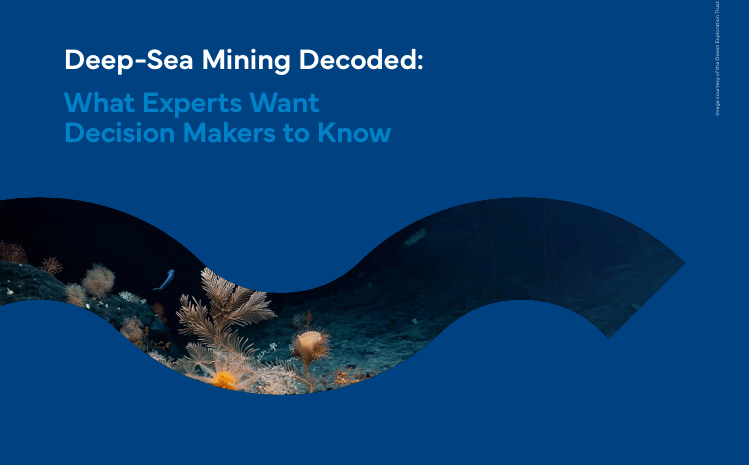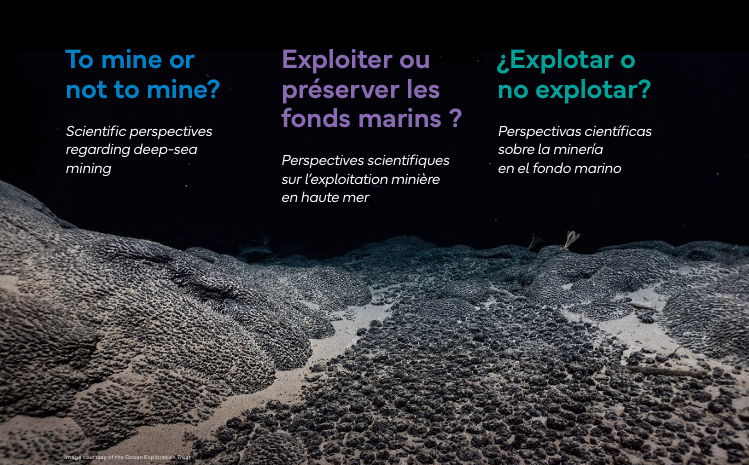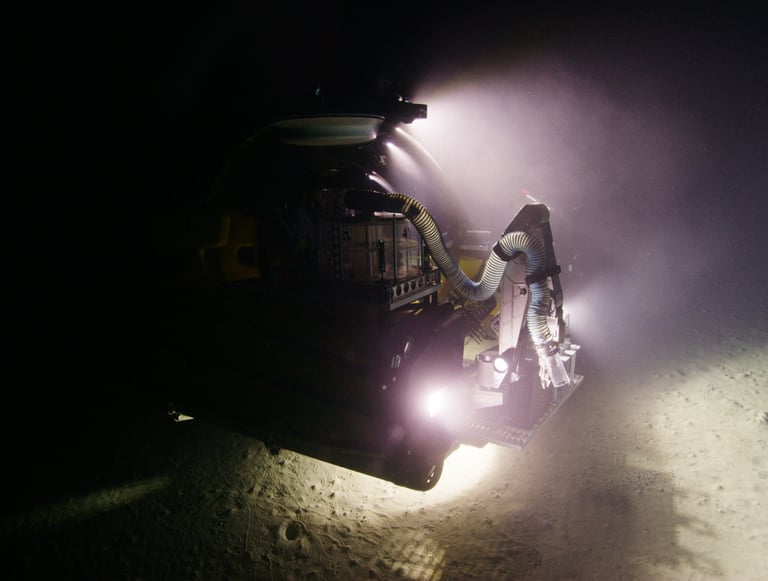The Global Deep Sea Consultation
In October 2023, French President Emmanuel Macron requested an international scientific consultation to synthesize the "scientific evidence concerning the serious risks that the international community would take by allowing the exploitation of the deep sea."
In response, Bruno David, President of the Muséum national d'histoire naturelle from 2015 to 2023, and Towards IPOS created an international scientific committee to compile expert advice and recommendations from deep-sea scientists and a large range of knowledge holders from around the globe. Our committee is co-chaired by Elva Escobar-Briones (Mexico) & Ricardo Serrão Santos (Portugal) and coordinated by Kelsey Archer Barnhill (United States).
This consultation worked on two main outputs: a brief position statement backed with signatures, and an expert question and answer booklet.




Q&A
Q&A booklet featuring 32 pressing questions on deep-sea mining, answered by international experts to inform policymakers:
Scientific Proclamation
Scientific Proclamation, a co-created position statement on deep-sea mining backed with the signatures of all 17 Scientific Committee Members and translated into French, Spanish and German:
Our scientific committee members were selected to represent diverse genders and geographical backgrounds, providing expertise in both natural and social sciences within the fields of deep-sea research, ocean governance, mineral resources, environmental economics, ecosystem management, and oceanography.
Our international and transdisciplinary approach aims to deliver inclusive and comprehensive insights to bridge the science-policy interface within the deep-sea mining debate.
Through compiling expert advice, insight, and recommendations from experts across disciplines and geographies, this Towards IPOS pilot project produces scientifically credible, contextually relevant, and globally resonant recommendations.
These outputs were launched on the 31st of March 2025 at the SOS Ocean event in Paris, France and were featured at the One Ocean Science Congress (3-6 June 2025) and UN Ocean Conference (28 May - 13 June 2025).
Reflections and Next Steps
Towards IPOS is honoured to have been part of this important international scientific consultation on deep-sea mining (DSM). This joint venture, carried out in partnership with Bruno David, was an opportunity to explore best practices for delivering rigorous science to inform policy, providing a working pilot study while IPOS was shaping its services and processes.
Read our document "Reflections and next steps".


Image courtesy of OceanX
Please direct any questions regarding the Global Deep Sea Consultation to our Deep Sea Coordinator, Kelsey Archer Barnhill at kelsey.barnhill[at]ipos.earth
Contributors
Scientific Committee Members
Diva Amon, Trinidad and Tobago
Sergio Cambronero, Costa Rica
Patrick d’Hugues, France
Elva Escobar-Briones, Mexico
Judith Gobin, Costa Rica
Bleuenn Guilloux, France
Peter M. Haugan, Norway
Nathalie Hilmi, Monaco
Baban Shravan Ingole, India
Aline Jaeckel, Australia
Lisa A. Levin, USA
Sandor Mulsow, Chile
Ricardo Serrão Santos, Portugal
Pradeep Singh, Malaysia
Alanna Matamaru Smith, The Cook Islands
Torsten Thiele, Germany
Hiroyuki Yamamoto, Japan
Participating Experts - Q&A
Elisa Morgera, UK
Vanessa Lopes, Cabo Verde
Kerry Sink, South Africa
Alycia Smith, UK
Gideon Sarpong, Ghana
Anna Metaxas, Canada
Sheena Talma, Seychelles
Sabine Gollner, The Netherlands
Baban Ingole, India
Endalew Lijalem Enyew, Norway
Transform Aqorau, Solomon Islands
Sophia Laarissa, Morocco
Houangninan Midinoudewa, Benin
Jonathon Moses, Norway
Bobbi-Jo Dobush, USA
Mehdi Remaoun, Algeria
Hannah Lily, UK
Edwin Egede, UK
Maila Guilhon, Brazil
Andrew D. Thaler, USA
Guillaume Bertrand, France
Jean-Dominique Senard, France
Victor L. Vescovo, USA
TBA21 Thyssen-Bornemisza Art Contemporary, Spain
References
Amon, D. J., Gollner, S., Morato, et al. (2022). Assessment of scientific gaps related to the effective environmental management of deep-seabed mining. Marine Policy, 138, 105006.
Amon, D. J., Palacios-Abrantes, J., Drazen, J. C. et al. (2023) Climate change to drive increasing overlap between Pacific tuna fisheries and emerging deep-sea mining industry. npj Ocean Sustainability 2, 9.
Ardron, J. A., Ruhl, H. A., & Jones, D. O. (2018). Incorporating transparency into the governance of deep-seabed mining in the Area beyond national jurisdiction. Marine Policy, 89, 58-66.
Blue Climate Initiative. Indigenous Voices for a Ban on Deep Sea Mining.
Bourrel, M., Thiele, T., & Currie, D. (2018). The common heritage of mankind as a means to assess and advance equity in deep sea mining. Marine Policy, 95, 311-316.
Brander, L. (2023). Guidance on the economic valuation of ecosystem services and natural capital of the Area.
Brander, L., and Guisado Goni, V. (2023). Report on the value of ecosystem services and natural capital of the Area.
Cuyvers, L., Berry, W., Gjerde, K., et al. (2018). Deep seabed mining, a rising environmental challenge. Gland, Switzerland: IUCN.
Deep-Sea Mining Scientific Statement. Marine Expert Statement Calling for a Pause to Deep-Sea Mining.
de Jonge, D. S., Stratmann, T., Lins, et al. (2020). Abyssal food-web model indicates faunal carbon flow recovery and impaired microbial loop 26 years after a sediment disturbance experiment. Progress in Oceanography, 189, 102446.
Drakou, E. G., Pendleton, L., Effron, M., Ingram, J. C., & Teneva, L. (2017). When ecosystems and their services are not co-located: oceans and coasts. ICES Journal of Marine Science, 74(6), 1531-1539.
Drazen, J. C., Smith, C. R., Gjerde, K. M., et al. (2020). Midwater ecosystems must be considered when evaluating environmental risks of deep-sea mining. Proceedings of the National Academy of Sciences, 117(30), 17455-17460.
Escobar, E., Guilloux, B., Howell, K., et al. (2021). The necessity of traditional knowledge for management of deep-seabed mining. DOSI Policy Brief.
Friedman, S. (2024). The interaction of the BBNJ agreement and the legal regime of the Area, and its influence on the implementation of the BBNJ agreement. Marine Policy, 167, 106235.
Greenpeace. Stop Deep Sea Mining Before it Starts.
Gollner, S., Kaiser, S., Menzel, L., Jones, D. O., Brown, A., Mestre, N. C., ... & Arbizu, P. M. (2017). Resilience of benthic deep-sea fauna to mining activities. Marine Environmental Research, 129, 76-101.
Hamley, G. J. (2022). The implications of seabed mining in the Area for the human right to health. Review of European, Comparative & International Environmental Law, 31(3), 389-398.
Haugan, P. M., Levin, L. A., Amon, D.J. et al. (2020) What Role for Ocean-Based Renewable Energy and Deep Seabed Minerals in a Sustainable Future? World Resources Institute. Washington, D.C.
Heinrich, L., & Koschinsky, A. (2022). Deep-Sea Mining: Can It Contribute to Sustainable Development? Sustainable Life Below Water, 109.
International Energy Agency. (2024). Global Critical Minerals Outlook 2024. IEA Publications
Jaeckel, A., Harden-Davies, H., Amon, D. J. et al. (2023). Deep seabed mining lacks social legitimacy. npj Ocean Sustainability, 2(1), 1.
Jobstvogt, N., Hanley, N., Hynes, S., Kenter, J., & Witte, U. (2014). Twenty thousand sterling under the sea: estimating the value of protecting deep-sea biodiversity. Ecological Economics, 97, 10-19.
Katona, S., Paulikas, D., Ali, S. et al. (2023) Land and deep-sea mining: the challenges of comparing biodiversity impacts. Biodiversity & Conservation 32, 1125–1164.
Koschinsky, A., Heinrich, L., Boehnke, K., et al. (2018). Deep‐sea mining: Interdisciplinary research on potential environmental, legal, economic, and societal implications. Integrated Environmental Assessment and Management, 14(6), 672-691.
Levin, L. A., Mengerink, K., Gjerde, K. M., et al. (2016). Defining “serious harm” to the marine environment in the context of deep-seabed mining. Marine Policy, 74, 245-259.
Levin, L. A., Amon, D.J., Lily, H. (2020). Challenges to the sustainability of deep-seabed mining. Nature Sustainability, 3, 784-794.
Lidström, S., Levin, L.A. & Seabrook, S. (2024) Laying waste to the deep: parallel narratives of marine carbon dioxide removal and deep-seabed mining. npj Ocean Sustainability 3, 36.
Morgera E. (2024). Participation of Indigenous Peoples in Decision Making Over Deep-Seabed Mining. AJIL Unbound, 118, 93-97.
Muñoz-Royo, C., Peacock, T., Alford, M.H. et al. (2021) Extent of impact of deep-sea nodule mining midwater plumes is influenced by sediment loading, turbulence and thresholds. Nature Communications Earth & Environment 2, 148.
Niner, H. J., Ardron, J. A., Escobar, E. G., et al. (2018). Deep-sea mining with no net loss of biodiversity—an impossible aim. Frontiers in Marine Science, 5, 53.
Orcutt, B. N., Bradley, J. A., Brazelton, W. J., Estes, E. R., Goordial, J. M., Huber, J. A., ... & Pachiadaki, M. (2020). Impacts of deep‐sea mining on microbial ecosystem services. Limnology and Oceanography, 65(7), 1489-1510.
Pickens, C., Lily, H., Harrould-Kolieb, E., et al. (2024). From what-if to what-now: Status of the deep-sea mining regulations and underlying drivers for outstanding issues. Marine Policy, 105967.
Rabone, M., Wiethase, J. H., Simon-Lledó, E. et al. (2023). How many metazoan species live in the world’s largest mineral exploration region? Current Biology, 33(12), 2383-2396.
Rademaekers, K., Widerberg, O., Svatikova, K., van der Veen, R., Consulting, T. E., Panella, E., & Ltd, M. (2015). Deep-seabed exploitation: Tackling economic, environmental and societal challenges. European Parliamentary Research Service Science Foresight Unit.
Ramirez-Llodra, E., Brandt, A., Danovaro et al. (2010) Deep, diverse and definitely different: unique attributes of the world's largest ecosystem, Biogeosciences, 7, 2851–2899
Revelle, R., & Suess, H. E. (1957). Carbon dioxide exchange between atmosphere and ocean and the question of an increase of atmospheric CO2 during the past decades. Tellus, 9(1), 18-27.
Roche, C., & Bice, S. (2013). Anticipating social and community impacts of deep sea mining. Deep Sea Minerals and the Green Economy, 2, 59-80.
Simon-Lledó, E., Bett, B. J., Huvenne, V. A., et al. (2019). Biological effects 26 years after simulated deep-sea mining. Scientific reports, 9(1), 8040.
Singh, P., & Jaeckel, A. (2024). Undermining by Mining? Deep Seabed Mining in Light of International Marine Environmental Law. AJIL Unbound, 118, 72-77.
Stop Deep Seabed Mining (2023). Business Statement Supporting a Moratorium on Deep Sea Mining.
Sweetman, A.K., Smith, A.J., de Jonge, D.S.W. et al. (2024). Evidence of dark oxygen production at the abyssal seafloor. Nature Geoscience, 17, 737-739.
Thiele, T. (2019). Deep-sea natural capital: putting deep-sea economic activities into an environmental context. In: Sharma, R. (eds) Environmental Issues of Deep-Sea Mining: Impacts, Consequences and Policy Perspectives, 507-518. Springer.
Thomas, E.A., Molloy, A., Hanson, N. et al. (2021). A Global Red List for Hydrothermal Vent Molluscs. Frontiers in Marine Science, 8.
Tilot, V., Willaert, K., Guilloux, B. et al. (2021). Traditional dimensions of seabed resource management in the context of Deep Sea Mining in the Pacific: learning from the socio-ecological interconnectivity between island communities and the ocean realm. Frontiers in Marine Science, 8, 637938.
USGS (2024) Mineral Commodity Summaries 2024. National Minerals Information Center
Van Dover, C. L., Ardron, J. A., Escobar, E. et al. (2017). Biodiversity loss from deep-sea mining. Nature Geoscience, 10(7), 464-465.
Vonnahme, T. R., Molari, M., Janssen, F. et al. (2020). Effects of a deep-sea mining experiment on seafloor microbial communities and functions after 26 years. Science Advances, 6(18).
Williams, R., Erbe, C., Duncan, A., Nielsen, K. et al. (2022). Noise from deep-sea mining may span vast ocean areas. Science, 377(6602), 157-158.

